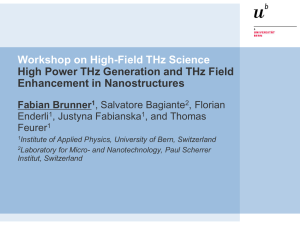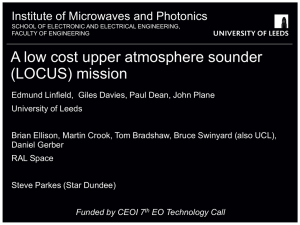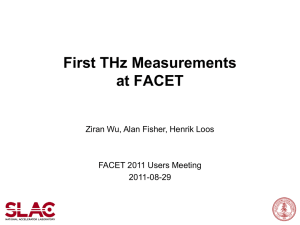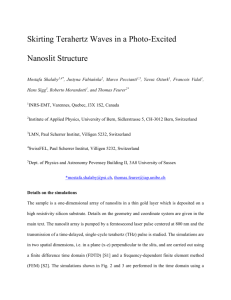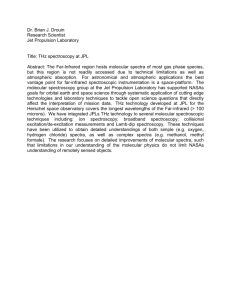Supplemental Material_2ndSubmission_151003
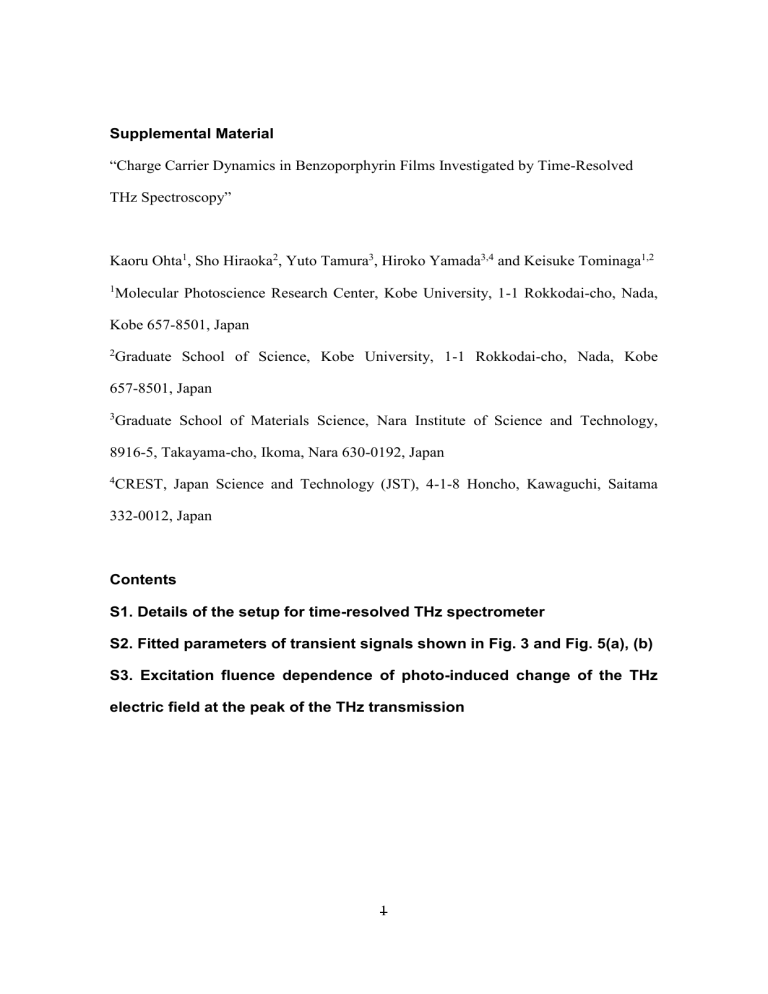
Supplemental Material
“Charge Carrier Dynamics in Benzoporphyrin Films Investigated by Time-Resolved
THz Spectroscopy”
Kaoru Ohta
1
, Sho Hiraoka
2
, Yuto Tamura
3
, Hiroko Yamada
3,4
and Keisuke Tominaga
1,2
1
Molecular Photoscience Research Center, Kobe University, 1-1 Rokkodai-cho, Nada,
Kobe 657-8501, Japan
2
Graduate School of Science, Kobe University, 1-1 Rokkodai-cho, Nada, Kobe
657-8501, Japan
3
Graduate School of Materials Science, Nara Institute of Science and Technology,
8916-5, Takayama-cho, Ikoma, Nara 630-0192, Japan
4
CREST, Japan Science and Technology (JST), 4-1-8 Honcho, Kawaguchi, Saitama
332-0012, Japan
Contents
S1. Details of the setup for time-resolved THz spectrometer
S2. Fitted parameters of transient signals shown in Fig. 3 and Fig. 5(a), (b)
S3. Excitation fluence dependence of photo-induced change of the THz electric field at the peak of the THz transmission
1
S1. Details of the setup for time-resolved THz spectrometer
A laser system was based on a Ti:sapphire regenerative amplifier, producing a
100 fs pulse with a center wavelength of 800 nm at a repetition rate of 1 kHz. The output was split into three, which were used for optical excitation of the sample, THz wave generation and detection, respectively. The optical pump pulses are second harmonic (400 nm) of the Ti:sapphire laser which is generated in a 1 mm thick BBO crystal. The THz probe pulses were generated by femtosecond laser-induced plasma.
1,2
The other BBO crystal with a thickness of 0.1 mm was used to generate a second harmonic pulse. Both the fundamental and second harmonic pulses were focused into nitrogen gas to produce a THz pulse by ionizing gas at the focal position. The THz pulse was collimated and focused onto the sample with a pair of gold-coated parabolic mirrors and overlapped collinearly with the optical pump pulses. After the sample, the electric fields of the THz probe pulses are measured by using an air-biased coherent detection scheme.
3
This was done by mixing THz pulses with the third 800 nm detection pulse to measure THz induced second harmonic generation. High voltage AC bias field of ± 1.5 kV at focal position was applied to produce a local oscillator for heterodyne detection. The beam profile and excitation fluence were estimated by using a knife edge method. Due to the absorption of the quartz substrate, Fourier amplitude spectrum ranges from around 10 cm -1 only up to 260 cm -1 as shown in Figure S1.
2
Figure S1. (a) Typical THz electric field of transmitted through a BP film without photo-excitation and (b) its Fourier amplitude spectrum.
3
S2. Fitted parameters of transient signals shown in Fig. 3 and Fig. 5(a), (b)
Photo-induced change of THz electric field amplitude as a function of optical pump/THz probe delay time was fitted with double exponential functions plus a constant offset for BP and BP:PCBM BHJ films.
E
E
A
1 exp
t
1
A
2 exp
t
1
A
0
The parameters are summarized as follows.
Sample
BP film
A
1
(x10
3
)
1
(ps) A
2
(x10
3
)
2
(ps) A
0
(x10
3
)
-6.0±0.3 0.5±0.1 -2.4±0.2 6.0±1.6 -0.3±0.1
BP:PCBM BHJ film -3.8±0.3 0.2±0.1 -1.9±0.2 2.9±0.5 -0.8±0.1
S3. Excitation fluence dependence of photo-induced change of the THz electric field at the peak of the THz transmission
Figure S2 shows excitation fluence dependence of photo-induced change of the
THz electric field at the peak of the THz transmission. The excitation fluence dependence was fitted by a power law of the form with –
E/E=Af B where f is the excitation fluence. We observed sub-linear fluence dependence of the photoconductivity
( B =0.70
± 0.07). Similar dependence was reported for polymer-fullerene photovoltaic blend films which was studied by time-resolved THz spectroscopy.
4 Sub-linear dependence was also observed for time-resolved microwave conductivity signals of poly(3-hexylthiophene) films.
5-7 This was attributed to exciton-exciton annihilation or quenching of excitons by holes. We can consider that at higher fluence exciton-exciton
4
annihilation
5,6
or quenching of excitons
7
by holes takes place and the yield of charge carriers is suppressed because these processes compete with exciton dissociation into mobile charge carriers.
Figure S2. Excitation fluence dependence of photo-induced change of THz electric field of BP films at the peak of the THz transmission (blue filled circles). Red line represents the fit of power law to data.
Figure S3 shows the normalized the photo-induced change of the THz electric field amplitude with increased excitation fluence. The decay dynamics within 4 ps time scale do not depend on the excitation fluence within our signal-to-noise ratio. It is noted that similar dependence was observed for photovoltaic polymer-fullerene films.
4
As discussed in this letter, early THz transients result from a reduction in carrier mobility as hot carriers relax to the thermalized state or formation of the excitons as shown in the recent studies of P3HT/PCBM BHJ films.
5
Figure S3. Normalized the photo-induced change of the THz electric field amplitude with increased excitation fluence.
6
References
1
D. J. Cook and R. M. Hochstrasser, Opt. Lett.
25 , 1210-1212 (2000).
2 J. Dai, J. Liu, and X. -C. Zhang, IEEE. J. Sel. Top. Quantum Electron. 17 , 183-190
(2011).
3
N. Karpowicz, J. Dai, X. Lu, Y. Chen, M. Yamaguchi, H. Zhao, X. –C. Zhang, L.
Zhang, C. Zhang, M. Price-Gallagher, C. Fletcher, O. Mamer, A. Lesimple, and K.
Johonson, Appl. Phys. Lett. 92 , 011131 (2008).
4
Z. Jin, D. Cehrig, C. Dyer-Smith, E. J. Heilweil, F. Laquai, M. Bonn, and D.
Turchinovich, J. Phys. Chem. Lett. 5 , 3662-3668 (2014).
5
G. Dicker, M. P. de Hass, L. D. A. Siebbeles, and J. M. Warman, Phys. Rev. B 70 ,
045203 (2004).
6
G. Dicker, M. P. de Hass, and L. D. A. Siebbeles, Phys. Rev. B 71 , 155204 (2005).
7 A. J. Ferguson, N. Kopidakis, S. E. Shaheen, and G. Rumbles, J. Phys. Chem. C 112 ,
9865-9871 (2008).
7


